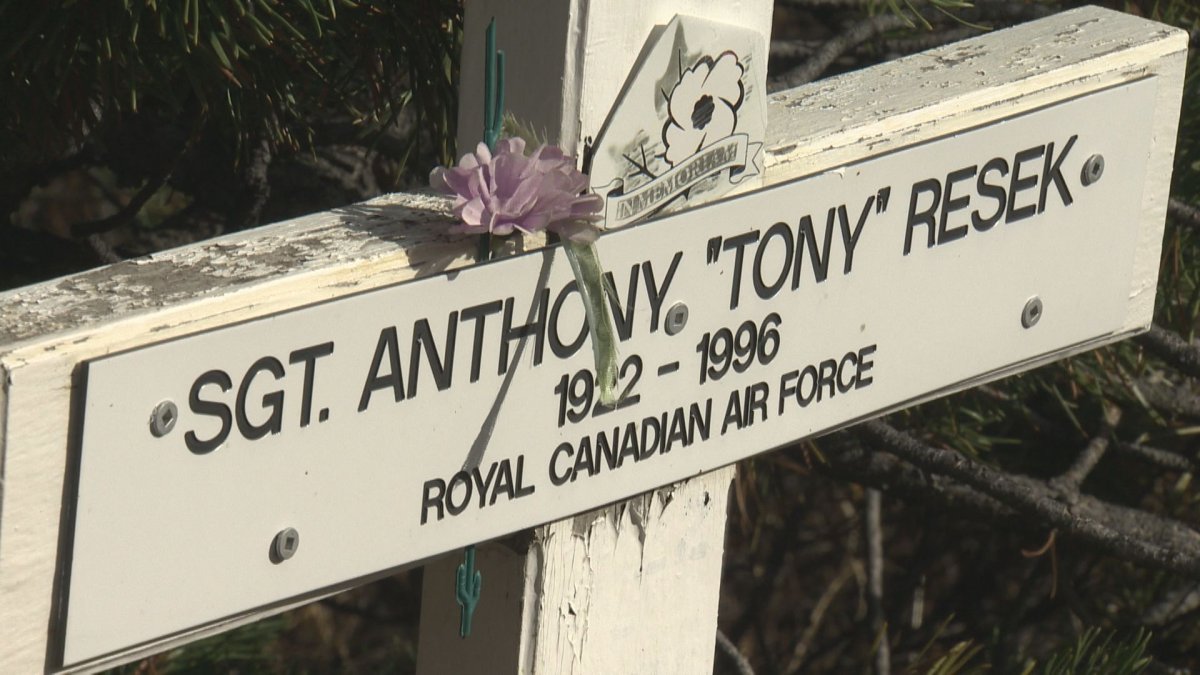From her couch in a downtown Edmonton seniors home, Mary Lee squints through her magnifying glass at the binder on her lap.

It’s mainly a photo album and it’s as thick as a bed pillow. Lee turns through the pages, trying to read the captions underneath each picture that she wrote years ago.
“I can see there’s colour, etcetera,” said Lee. “But I can’t tell the details.”
The binder she’s leafing through is actually less than half of what she’s collected about Mountain Park Cemetery, the only remnants of a community abandoned 72 years ago.
More than 300 kilometres west of Lee and her binders, in the Alberta foothills, 31 small flags flap and flicker in what used to be called the “Valley of the Winds.”
‘It’s gone back to nature’
Established in 1911, Mountain Park was a tight-knit coal mining community built on a hillside about 15 kilometres south of Cadomin in the Rocky Mountain foothills.
Mainly accessible by train, it had a school, hospital, library, butcher shop, hockey rink and a cemetery.
“Everybody got along. We never locked our doors,” she recalled.
Population peaked around 1,500 residents, some of whom fought in both the First and Second World Wars.
“We sent care packages over(seas) like you wouldn’t believe,” said Lee. “My mother made fruit cakes and everything and sent them over to the boys.”
Eventually, the oil and gas industry began to emerge in Alberta.
Alberta Coal Branch mining operations in Mountain Park wound down.
Flooding on the McLeod River cut off the integral railway.
In 1950, Mountain Park was abandoned. Lee recalled residents moving their entire homes from their foundation to other communities. Other structures were flattened.
Today, it’s considered a ghost town.
“There’s nothing there anymore. It’s gone back to nature,” said Lee.
To this day, the only visible evidence Mountain Park ever existed is its cemetery.
“We kind of forgot it was there.”
Mary’s reclamation project
Lee moved north to Edson, west of Edmonton, after her Mountain Park days. But in the 1990s, the cemetery was suddenly back on her radar.
Another ex-resident was informed the cemetery was in jeopardy of being demolished by a mining company. A group, including Lee, began an initiative to save it.
After receiving a government grant, work began on the reclamation and Lee revisited the site for the first time in years.
“The buckbrush was up to my shoulders, probably. And as we cleaned it out, we were surprised what was there,” recalled Lee.
The surprise came at the number of graves belonging to war veterans.
Lee sought out to determine exactly who the graves belonged to.
Some were unmarked or damaged. Wooden fences built to protect the plots needed to be rebuilt and repainted.
In the early 2000s, a cenotaph was erected in honour of Mountain Park’s residents who served and sacrificed.
In the years following, Lee would return a few times per year to visit her parents and ensure the cemetery didn’t become enveloped by nature.
But in time, time caught up with her. Lee hasn’t been back since 2017.
A new form of recognition
Arleen Wambolt doesn’t claim to know much about the history of Mountain Park. Wambolt was aware the cemetery had a military contingent and of Lee’s efforts to preserve it all.
“It’s amazing she took this on,” said Wambolt of Lee.
Wambolt volunteers with No Stone Left Alone Foundation in Hinton. The initiative organizes youth to place poppies on the headstones of Canadian veterans each November.
This year, she was tasked with bringing a commemoration ceremony to Mountain Park cemetery.
“It doesn’t matter if the cemetery has one veteran or 1,000. It’s honouring every veteran that served our country,” said Wambolt.
At more than 6,000 feet above sea level, Mountain Park has the highest elevated cemetery in Canada. That can make weather and road conditions unpredictable, especially in the winter.
Wambolt knew the ceremony couldn’t wait for November.
In August, she and some friends drove the winding gravel road to the cemetery. Instead of poppies, which would easily blow away, they planted poppy flags next to headstones. Wambolt counted 31 in total.
“It’s just moving. You almost reflect at each one that you do it. You kind of thank them silently for their service,” she said.
“I kind of get chills when I do it.”
The reason this is here is because of Mountain Park
The buzz of a weedwacker fills the air with sound, as Paula (Resek) McKay chops down some overgrown grass. The Resek family had a home in Mountain Park pre-1950.
“My dad’s house was up on one of those hills over there,” said McKay, pointing to the hillside and former townsite west of the cemetery.
She was careful not to damage the white cross of Sgt. Tony Resek, her cousin, who served with the Royal Canadian Air Force.
Resek is one of the 31 markers Wambolt counted. No one seems to believe any of the veterans physically buried at Mountain Park actually died in combat. Many served and died in the First World War but others also served and returned to Canada to live out their lives.
Some returned to Mountain Park and they or their families requested to be buried at the cemetery upon their death.
“I think about all the young men from Mountain Park that answered the call to go to war,” said McKay, who helped with the No Stone commemoration ceremony in August.
The August ceremony was missing a youth component.
Most of the broader area’s school-aged children live in or close to Hinton and Edson on the Yellowhead Highway, according to Wambolt.
Her hope is to work with county school divisions to organize a youth contingent to travel to Mountain Park to plant the poppy flags as soon as next year.
“I’d like to see more youth coming out here. Maybe through a field trip?” suggested McKay.
Longing to return
Lee would happily host a youth expedition to Mountain Park.
But while flipping through her photo album, she’s reminded of why she cannot.
“I’m sitting here and I’m realizing how much of the vision is gone,” said Lee, who is visually impaired.
But her memories are not fuzzy and the motivation behind her cemetery custodianship is as clear now as it was 25 years ago.
“That’s part of the history from up there that should not die,” she said, vowing to return one way or another.
“I’ll tell you right now, that’s where I’m heading back to. So you better look after it good,” Lee said with a chuckle.
- Roll Up To Win? Tim Hortons says $55K boat win email was ‘human error’
- Ontario premier calls cost of gas ‘absolutely disgusting,’ raises price-gouging concerns
- Bird flu risk to humans an ‘enormous concern,’ WHO says. Here’s what to know
- Election interference worse than government admits, rights coalition says

























Comments